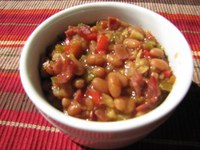Prairie Fare: Beans Are a Tasty Summer Side Dish
(Click an image below to view a high-resolution image that can be downloaded)
By Julie Garden-Robinson, Food and Nutrition Specialist
NDSU Extension
“The beans are cold!” my husband exclaimed. We were at a picnic with pork and beans as a side dish.
I looked at him a little oddly.
“Yes, they’re cold,” I said. “Haven’t you ever had cold pork and beans?”
He looked at me as though I had handed him a cup of dishwater to drink. We enjoy beans in lots of different recipes regularly.
“Beans are supposed to be served hot,” he remarked a little indignantly.
“I can tell you didn’t grow up here,” I said. “We had cold pork and beans sometimes when I was a little kid.
“They won’t hurt you if you eat them cold, by the way,” I added. “They are safe to eat right out of the can.”
He wasn’t sold on the concept of cold beans, so he did some research.
“I found lots of debate online about whether beans should be served cold or hot,” he said with a grin. “It’s controversial.”
Somehow I don’t see lots of cold beans on our future menus.
Whether you enjoy beans, such as pinto, navy, kidney, pink and black beans, in hot or cold dishes, be sure to add some to your diet.
Beans are among the best sources of dietary fiber. On average, 1/2 cup of beans provides about 7 grams of fiber, or about one-fourth of the daily recommendation.
They are an excellent source of protein and the B vitamin folate. Adequate folate plays a role in the production of red blood cells. Adequate intake of folate or its man-made form (folic acid) during pregnancy helps prevent birth defects in newborns. Beans also provide minerals such as calcium, iron, potassium and magnesium.
Beans usually play a major role in a vegetarian diet because of their protein content. In fact, they count as a protein food or a vegetable. Beans are naturally gluten-free, which makes them beneficial for those who must avoid gluten for medical reasons.
Canned beans are a convenient option, and many flavor options are available, from pork and beans to spicy beans to plain beans. If you start with canned beans, such as kidney or navy beans, be sure to drain and rinse them. This step reduces the sodium content by up to 40 percent. As another option, you can buy low- or reduced-sodium beans.
Beans are budget-friendly, especially when you begin with dry beans, which typically require a soaking process to soften them before cooking. Here are 10 tips for cooking dry beans from our “All About Beans” Extension publication. We also have a bean cookbook with dozens of recipes to inspire your menus. See https://www.ag.ndsu.edu/food/bean-resources-1 for more information.
- To cook soaked beans, add fresh, cold water to fully cover beans, plus 1 to 2 tablespoons of oil, if you wish. Adding oil prevents foaming and boiling over. Foam also can be skimmed off during cooking. Simmer the beans until they are tender.
- Cook only one kind of bean at a time if possible. Different types of beans have different cooking times, so avoid cooking different types of beans together.
- Maintain water at a gentle simmer (not a rapid boil) during cooking to prevent split skins.
- Avoid adding baking soda to beans. This may make beans more tender but may affect the vitamin content and may impact the flavor negatively. Adding baking soda also increases the sodium content.
- Stir beans occasionally to prevent sticking during cooking.
- Keep beans covered with water during the cooking process. Add cold water periodically during cooking to ensure beans are covered.
- Check beans for doneness before eating. They should be tender but not mushy.
- Drain beans immediately after they have reached the desired texture.
- To add flavor after beans have finished cooking, try adding a drizzle of extra virgin olive oil immediately before serving.
- To cook beans quickly, try a pressure cooker, following the manufacturer’s directions. The quick cooking does not give the beans much time to absorb flavors from other ingredients, so use a pressure cooker when beans are needed quickly or will be used as a part of another flavorful dish.
Here’s a tasty bean recipe that is a great accompaniment to a backyard barbecue.
Sizzlin’ Baked Beans
1 (28-ounce) can vegetarian baked beans, undrained
1/2 green pepper, chopped
1/2 red pepper, chopped
1 onion, chopped
1 1/2 Tbsp. molasses
1 1/2 Tbsp. ketchup
4 strips uncooked turkey bacon, diced (or regular bacon)
Salt and pepper to taste
In a 9- by 13-inch greased pan, mix all ingredients, except turkey bacon. Brown turkey bacon and drain fat. Crumble and sprinkle turkey bacon evenly over the top. Bake in preheated oven at 350 F for 40 minutes. Makes 12 servings. Per serving: 100 calories, 1.5 grams (g) fat, 5 g protein, 19 g carbohydrate, 4 g fiber and 360 milligrams sodium
(Julie Garden-Robinson, Ph.D., R.D., L.R.D., is a North Dakota State University Extension food and nutrition specialist and professor in the Department of Health, Nutrition and Exercise Sciences. Follow her on Twitter @jgardenrobinson)
NDSU Agriculture Communication - July 26, 2018
| Source: | Julie Garden-Robinson, 701-231-7187, julie.garden-robinson@ndsu.edu |
|---|---|
| Editor: | Ellen Crawford, 701-231-5391, ellen.crawford@ndsu.edu |



